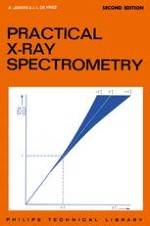1970 | OriginalPaper | Buchkapitel
Quantitative Analysis
verfasst von : R. Jenkins, J. L. De Vries
Erschienen in: Practical X-Ray Spectrometry
Verlag: Macmillan Education UK
Enthalten in: Professional Book Archive
Aktivieren Sie unsere intelligente Suche, um passende Fachinhalte oder Patente zu finden.
Wählen Sie Textabschnitte aus um mit Künstlicher Intelligenz passenden Patente zu finden. powered by
Markieren Sie Textabschnitte, um KI-gestützt weitere passende Inhalte zu finden. powered by
The preceding chapters have discussed the various random and systematic errors which can arise during an analysis either from the equipment or from the sample to be analysed and it is the purpose of this section to discuss the methods which are available for reducing these errors to an acceptable value. The first problem is however, to define an acceptable value. Instrumental techniques are invariably adopted for one reason only, this being the inherent speed of the instrumental method compared to classical wet techniques. Since practically all analytical instruments are nothing more than rapid, versatile and frequently very expensive comparison devices, recourse has nearly always to be made to the use of chemically analysed or synthesised standards. Basically no data obtainable by an instrumental technique can be more accurate than that of the standards with which they were compared, although the random errors of the chemical analysis can be reduced by graphical or mathematical interpolation. A calibration graph is thus inherently more precise than its individual points. It is frequently impracticable to start with basic measurements of weight, volume etc. and one must invariably accept either the chemically or synthesised standard as the ultimate limit to the accuracy obtainable, or settle for very precise trend information which may or may not be of comparable accuracy.
